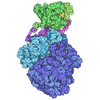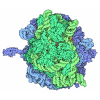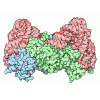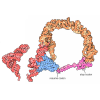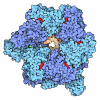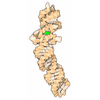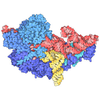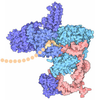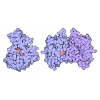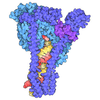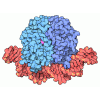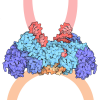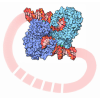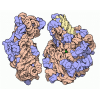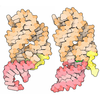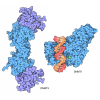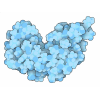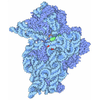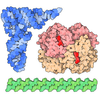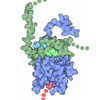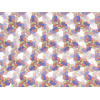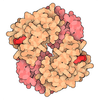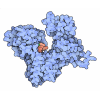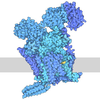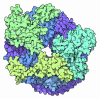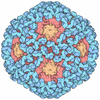+ Open data
Open data
- Basic information
Basic information
| Entry | Database: PDB / ID: 9rtt | ||||||
|---|---|---|---|---|---|---|---|
| Title | Activated Elongation Complex with IWS1 and ELOF1 | ||||||
 Components Components |
| ||||||
 Keywords Keywords | TRANSCRIPTION / RNA Pol II / Elongation | ||||||
| Function / homology |  Function and homology information Function and homology informationblastocyst growth / Ski complex / RNA polymerase II C-terminal domain phosphoserine binding / mRNA decay by 3' to 5' exoribonuclease / Cdc73/Paf1 complex / regulation of mRNA export from nucleus / inner cell mass cell differentiation / positive regulation of mRNA 3'-end processing / regulation of isotype switching / nuclear-transcribed mRNA catabolic process, 3'-5' exonucleolytic nonsense-mediated decay ...blastocyst growth / Ski complex / RNA polymerase II C-terminal domain phosphoserine binding / mRNA decay by 3' to 5' exoribonuclease / Cdc73/Paf1 complex / regulation of mRNA export from nucleus / inner cell mass cell differentiation / positive regulation of mRNA 3'-end processing / regulation of isotype switching / nuclear-transcribed mRNA catabolic process, 3'-5' exonucleolytic nonsense-mediated decay / negative regulation of DNA-templated transcription, elongation / regulation of muscle cell differentiation / endodermal cell fate commitment / negative regulation of myeloid cell differentiation / positive regulation of cell cycle G1/S phase transition / DSIF complex / regulation of mRNA processing / trophectodermal cell differentiation / regulation of transcription elongation by RNA polymerase II / blastocyst hatching / nucleosome organization / Formation of RNA Pol II elongation complex / Formation of the Early Elongation Complex / Transcriptional regulation by small RNAs / RNA Polymerase II Pre-transcription Events / TP53 Regulates Transcription of DNA Repair Genes / FGFR2 alternative splicing / RNA polymerase II transcribes snRNA genes / mRNA Capping / mRNA Splicing - Minor Pathway / Processing of Capped Intron-Containing Pre-mRNA / RNA Polymerase II Promoter Escape / RNA Polymerase II Transcription Pre-Initiation And Promoter Opening / RNA Polymerase II Transcription Initiation / RNA Polymerase II Transcription Elongation / RNA Polymerase II Transcription Initiation And Promoter Clearance / RNA Pol II CTD phosphorylation and interaction with CE / Estrogen-dependent gene expression / Formation of TC-NER Pre-Incision Complex / Dual incision in TC-NER / Gap-filling DNA repair synthesis and ligation in TC-NER / mRNA Splicing - Major Pathway / blastocyst formation / mRNA 3'-end processing / nuclear lumen / positive regulation of DNA-templated transcription, elongation / Abortive elongation of HIV-1 transcript in the absence of Tat / poly(A)+ mRNA export from nucleus / stem cell population maintenance / interleukin-6-mediated signaling pathway / negative regulation of G1/S transition of mitotic cell cycle / negative regulation of gene expression, epigenetic / RNA Pol II CTD phosphorylation and interaction with CE during HIV infection / RNA Pol II CTD phosphorylation and interaction with CE / transcription elongation-coupled chromatin remodeling / Formation of the Early Elongation Complex / Formation of the HIV-1 Early Elongation Complex / mRNA Capping / RNA polymerase II complex binding / maintenance of transcriptional fidelity during transcription elongation by RNA polymerase II / Pausing and recovery of Tat-mediated HIV elongation / Tat-mediated HIV elongation arrest and recovery / negative regulation of transcription elongation by RNA polymerase II / positive regulation of macroautophagy / RNA polymerase II transcribes snRNA genes / HIV elongation arrest and recovery / Pausing and recovery of HIV elongation / protein localization to nucleus / positive regulation of Wnt signaling pathway / cell surface receptor signaling pathway via JAK-STAT / mRNA transport / Tat-mediated elongation of the HIV-1 transcript / Formation of HIV-1 elongation complex containing HIV-1 Tat / RNA polymerase I complex / transcription elongation by RNA polymerase I / RNA polymerase III complex / negative regulation of fibroblast proliferation / Formation of HIV elongation complex in the absence of HIV Tat / RNA polymerase II, core complex / tRNA transcription by RNA polymerase III / nucleosome binding / RNA Polymerase II Transcription Elongation / Formation of RNA Pol II elongation complex / translation initiation factor binding / transcription-coupled nucleotide-excision repair / RNA Polymerase II Pre-transcription Events / rescue of stalled ribosome / SH2 domain binding / DNA-directed RNA polymerase complex / RNA splicing / transcription elongation factor complex / TP53 Regulates Transcription of DNA Repair Genes / transcription initiation at RNA polymerase II promoter / transcription elongation by RNA polymerase II / regulation of cell growth / DNA-templated transcription initiation / positive regulation of transcription elongation by RNA polymerase II / Hedgehog 'on' state / euchromatin / Formation of the beta-catenin:TCF transactivating complex Similarity search - Function | ||||||
| Biological species |  Homo sapiens (human) Homo sapiens (human) synthetic construct (others) | ||||||
| Method | ELECTRON MICROSCOPY / single particle reconstruction / cryo EM / Resolution: 4.01 Å | ||||||
 Authors Authors | Walshe, J.L. / Cramer, P. | ||||||
| Funding support |  Germany, 1items Germany, 1items
| ||||||
 Citation Citation |  Journal: Nat Commun / Year: 2025 Journal: Nat Commun / Year: 2025Title: IWS1 positions downstream DNA to globally stimulate Pol II elongation. Authors: Aiturgan Zheenbekova / James L Walshe / Moritz Ochmann / Moritz Bäuerle / Ute Neef / Kerstin C Maier / Petra Rus / Yumeng Yan / Henning Urlaub / Patrick Cramer / Kristina Žumer /  Abstract: The protein IWS1 (Interacts with SPT6 1) is implicated in transcription-associated processes, but a direct role in RNA polymerase (Pol) II function is unknown. Here, we use multi-omics kinetic ...The protein IWS1 (Interacts with SPT6 1) is implicated in transcription-associated processes, but a direct role in RNA polymerase (Pol) II function is unknown. Here, we use multi-omics kinetic analysis after rapid depletion of IWS1 in human cells to show that loss of IWS1 results in a global decrease of RNA synthesis and a global reduction in Pol II elongation velocity. We then resolve the cryo-EM structure of the activated Pol II elongation complex with bound IWS1 and elongation factor ELOF1 and show that IWS1 acts as a scaffold and positions downstream DNA within the cleft of Pol II. In vitro assays show that the disordered C-terminal region of IWS1 that contacts the cleft of Pol II is responsible for stimulation of Pol II activity and is aided by ELOF1. Finally, we find that the defect in transcription upon IWS1 depletion leads to a decrease of histone H3 tri-methylation at residue lysine-36 (H3K36me3), but that this secondary effect is an indirect function of IWS1. In summary, our structure-function analysis establishes IWS1 as a Pol II-associated elongation factor that acts globally to stimulate Pol II elongation velocity and ensure proper co-transcriptional histone methylation. | ||||||
| History |
|
- Structure visualization
Structure visualization
| Structure viewer | Molecule:  Molmil Molmil Jmol/JSmol Jmol/JSmol |
|---|
- Downloads & links
Downloads & links
- Download
Download
| PDBx/mmCIF format |  9rtt.cif.gz 9rtt.cif.gz | 1.7 MB | Display |  PDBx/mmCIF format PDBx/mmCIF format |
|---|---|---|---|---|
| PDB format |  pdb9rtt.ent.gz pdb9rtt.ent.gz | Display |  PDB format PDB format | |
| PDBx/mmJSON format |  9rtt.json.gz 9rtt.json.gz | Tree view |  PDBx/mmJSON format PDBx/mmJSON format | |
| Others |  Other downloads Other downloads |
-Validation report
| Summary document |  9rtt_validation.pdf.gz 9rtt_validation.pdf.gz | 1.9 MB | Display |  wwPDB validaton report wwPDB validaton report |
|---|---|---|---|---|
| Full document |  9rtt_full_validation.pdf.gz 9rtt_full_validation.pdf.gz | 2 MB | Display | |
| Data in XML |  9rtt_validation.xml.gz 9rtt_validation.xml.gz | 193.6 KB | Display | |
| Data in CIF |  9rtt_validation.cif.gz 9rtt_validation.cif.gz | 313.8 KB | Display | |
| Arichive directory |  https://data.pdbj.org/pub/pdb/validation_reports/rt/9rtt https://data.pdbj.org/pub/pdb/validation_reports/rt/9rtt ftp://data.pdbj.org/pub/pdb/validation_reports/rt/9rtt ftp://data.pdbj.org/pub/pdb/validation_reports/rt/9rtt | HTTPS FTP |
-Related structure data
| Related structure data |  54251MC C: citing same article ( M: map data used to model this data |
|---|---|
| Similar structure data | Similarity search - Function & homology  F&H Search F&H Search |
- Links
Links
- Assembly
Assembly
| Deposited unit | 
|
|---|---|
| 1 |
|
- Components
Components
-RNA polymerase II subunit ... , 2 types, 2 molecules DL
| #1: Protein | Mass: 16331.255 Da / Num. of mol.: 1 / Source method: isolated from a natural source / Source: (natural)  |
|---|---|
| #9: Protein | Mass: 7018.244 Da / Num. of mol.: 1 / Source method: isolated from a natural source / Source: (natural)  |
-DNA-directed RNA polymerase ... , 7 types, 7 molecules EGIKABC
| #2: Protein | Mass: 24644.318 Da / Num. of mol.: 1 / Source method: isolated from a natural source / Source: (natural)  |
|---|---|
| #4: Protein | Mass: 19314.283 Da / Num. of mol.: 1 / Source method: isolated from a natural source / Source: (natural)  |
| #6: Protein | Mass: 14541.221 Da / Num. of mol.: 1 / Source method: isolated from a natural source / Source: (natural)  |
| #8: Protein | Mass: 13310.284 Da / Num. of mol.: 1 / Source method: isolated from a natural source / Source: (natural)  |
| #16: Protein | Mass: 217610.031 Da / Num. of mol.: 1 / Source method: isolated from a natural source / Source: (natural)  References: UniProt: A0A8D1DPV6, DNA-directed RNA polymerase |
| #17: Protein | Mass: 134041.422 Da / Num. of mol.: 1 / Source method: isolated from a natural source / Source: (natural)  |
| #18: Protein | Mass: 31439.074 Da / Num. of mol.: 1 / Source method: isolated from a natural source / Source: (natural)  |
-DNA-directed RNA polymerases I, II, and III subunit ... , 3 types, 3 molecules FHJ
| #3: Protein | Mass: 14477.001 Da / Num. of mol.: 1 / Source method: isolated from a natural source / Source: (natural)  |
|---|---|
| #5: Protein | Mass: 17162.273 Da / Num. of mol.: 1 / Source method: isolated from a natural source / Source: (natural)  |
| #7: Protein | Mass: 7655.123 Da / Num. of mol.: 1 / Source method: isolated from a natural source / Source: (natural)  |
-RNA chain , 1 types, 1 molecules P
| #10: RNA chain | Mass: 6636.885 Da / Num. of mol.: 1 / Source method: obtained synthetically / Source: (synth.) synthetic construct (others) |
|---|
-RNA polymerase-associated protein ... , 2 types, 2 molecules QU
| #11: Protein | Mass: 134510.203 Da / Num. of mol.: 1 Source method: isolated from a genetically manipulated source Source: (gene. exp.)  Homo sapiens (human) / Gene: CTR9, KIAA0155, SH2BP1 / Production host: Homo sapiens (human) / Gene: CTR9, KIAA0155, SH2BP1 / Production host:  Trichoplusia ni (cabbage looper) / References: UniProt: Q6PD62 Trichoplusia ni (cabbage looper) / References: UniProt: Q6PD62 |
|---|---|
| #21: Protein | Mass: 75514.172 Da / Num. of mol.: 1 Source method: isolated from a genetically manipulated source Source: (gene. exp.)  Homo sapiens (human) / Gene: LEO1, RDL / Production host: Homo sapiens (human) / Gene: LEO1, RDL / Production host:  Trichoplusia ni (cabbage looper) / References: UniProt: Q8WVC0 Trichoplusia ni (cabbage looper) / References: UniProt: Q8WVC0 |
-DNA chain , 2 types, 2 molecules TN
| #12: DNA chain | Mass: 78779.328 Da / Num. of mol.: 1 / Source method: obtained synthetically / Source: (synth.) synthetic construct (others) |
|---|---|
| #20: DNA chain | Mass: 76916.625 Da / Num. of mol.: 1 / Source method: obtained synthetically / Source: (synth.) synthetic construct (others) |
-Protein , 4 types, 4 molecules WVXa
| #13: Protein | Mass: 33617.465 Da / Num. of mol.: 1 Source method: isolated from a genetically manipulated source Source: (gene. exp.)  Homo sapiens (human) / Gene: SKIC8, WDR61 / Production host: Homo sapiens (human) / Gene: SKIC8, WDR61 / Production host:  Trichoplusia ni (cabbage looper) / References: UniProt: Q9GZS3 Trichoplusia ni (cabbage looper) / References: UniProt: Q9GZS3 |
|---|---|
| #22: Protein | Mass: 60052.672 Da / Num. of mol.: 1 Source method: isolated from a genetically manipulated source Source: (gene. exp.)  Homo sapiens (human) / Gene: PAF1, PD2 / Production host: Homo sapiens (human) / Gene: PAF1, PD2 / Production host:  Trichoplusia ni (cabbage looper) / References: UniProt: Q8N7H5 Trichoplusia ni (cabbage looper) / References: UniProt: Q8N7H5 |
| #23: Protein | Mass: 60673.539 Da / Num. of mol.: 1 Source method: isolated from a genetically manipulated source Source: (gene. exp.)  Homo sapiens (human) / Gene: CDC73, C1orf28, HRPT2 / Production host: Homo sapiens (human) / Gene: CDC73, C1orf28, HRPT2 / Production host:  Trichoplusia ni (cabbage looper) / References: UniProt: Q6P1J9 Trichoplusia ni (cabbage looper) / References: UniProt: Q6P1J9 |
| #25: Protein | Mass: 92235.883 Da / Num. of mol.: 1 Source method: isolated from a genetically manipulated source Source: (gene. exp.)  Homo sapiens (human) / Gene: IWS1, IWS1L / Production host: Homo sapiens (human) / Gene: IWS1, IWS1L / Production host:  Trichoplusia ni (cabbage looper) / References: UniProt: Q96ST2 Trichoplusia ni (cabbage looper) / References: UniProt: Q96ST2 |
-Transcription elongation factor ... , 4 types, 4 molecules YbMZ
| #14: Protein | Mass: 13508.496 Da / Num. of mol.: 1 Source method: isolated from a genetically manipulated source Source: (gene. exp.)  Homo sapiens (human) / Gene: SUPT4H1, SPT4H, SUPT4H / Production host: Homo sapiens (human) / Gene: SUPT4H1, SPT4H, SUPT4H / Production host:  |
|---|---|
| #15: Protein | Mass: 9616.944 Da / Num. of mol.: 1 Source method: isolated from a genetically manipulated source Source: (gene. exp.)  Homo sapiens (human) / Gene: ELOF1 / Production host: Homo sapiens (human) / Gene: ELOF1 / Production host:  Trichoplusia ni (cabbage looper) / References: UniProt: P60002 Trichoplusia ni (cabbage looper) / References: UniProt: P60002 |
| #19: Protein | Mass: 199602.969 Da / Num. of mol.: 1 Source method: isolated from a genetically manipulated source Source: (gene. exp.)  Homo sapiens (human) / Gene: SUPT6H, KIAA0162, SPT6H / Production host: Homo sapiens (human) / Gene: SUPT6H, KIAA0162, SPT6H / Production host:  Trichoplusia ni (cabbage looper) / References: UniProt: Q7KZ85 Trichoplusia ni (cabbage looper) / References: UniProt: Q7KZ85 |
| #24: Protein | Mass: 121145.477 Da / Num. of mol.: 1 Source method: isolated from a genetically manipulated source Source: (gene. exp.)  Homo sapiens (human) / Gene: SUPT5H, SPT5, SPT5H / Production host: Homo sapiens (human) / Gene: SUPT5H, SPT5, SPT5H / Production host:  |
-Non-polymers , 2 types, 10 molecules 


| #26: Chemical | ChemComp-ZN / #27: Chemical | ChemComp-MG / | |
|---|
-Details
| Has ligand of interest | N |
|---|---|
| Has protein modification | Y |
-Experimental details
-Experiment
| Experiment | Method: ELECTRON MICROSCOPY |
|---|---|
| EM experiment | Aggregation state: PARTICLE / 3D reconstruction method: single particle reconstruction |
- Sample preparation
Sample preparation
| Component | Name: Activated Elongation Complex (ECstar) with IWS1 and ELOF1 Type: COMPLEX Entity ID: #16-#18, #1-#9, #19-#20, #10-#12, #21-#22, #13, #23, #14, #24-#25, #15 Source: RECOMBINANT |
|---|---|
| Molecular weight | Value: 1315755.43 MDa / Experimental value: NO |
| Source (natural) | Organism:  Homo sapiens (human) Homo sapiens (human) |
| Source (recombinant) | Organism:  Trichoplusia ni (cabbage looper) Trichoplusia ni (cabbage looper) |
| Buffer solution | pH: 7.4 |
| Specimen | Embedding applied: NO / Shadowing applied: NO / Staining applied: NO / Vitrification applied: YES |
| Vitrification | Cryogen name: ETHANE |
- Electron microscopy imaging
Electron microscopy imaging
| Experimental equipment |  Model: Titan Krios / Image courtesy: FEI Company |
|---|---|
| Microscopy | Model: TFS KRIOS |
| Electron gun | Electron source:  FIELD EMISSION GUN / Accelerating voltage: 300 kV / Illumination mode: FLOOD BEAM FIELD EMISSION GUN / Accelerating voltage: 300 kV / Illumination mode: FLOOD BEAM |
| Electron lens | Mode: BRIGHT FIELD / Nominal defocus max: 2000 nm / Nominal defocus min: 500 nm |
| Image recording | Electron dose: 40.03 e/Å2 / Film or detector model: GATAN K3 (6k x 4k) |
- Processing
Processing
| EM software |
| ||||||||||||
|---|---|---|---|---|---|---|---|---|---|---|---|---|---|
| CTF correction | Type: PHASE FLIPPING AND AMPLITUDE CORRECTION | ||||||||||||
| 3D reconstruction | Resolution: 4.01 Å / Resolution method: FSC 0.143 CUT-OFF / Num. of particles: 1837 / Symmetry type: POINT |
 Movie
Movie Controller
Controller














 PDBj
PDBj